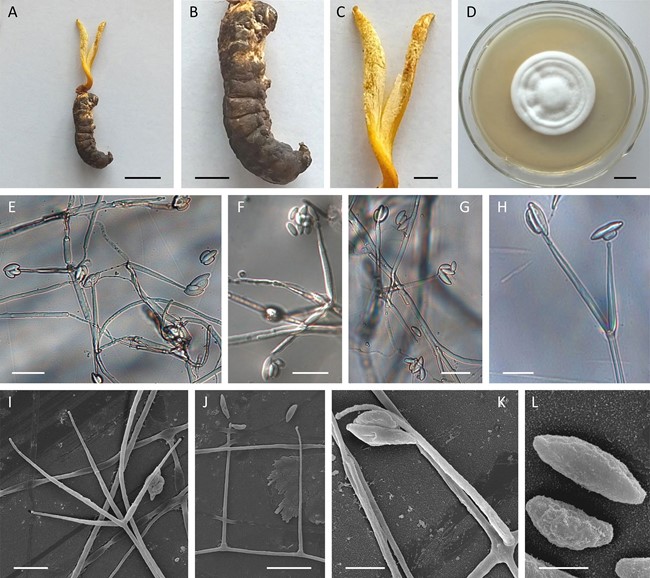Flavocillium bifurcatum H. Yu, Y.B. Wang, Y. Wang, Q. Fan & Zhu L. Yang, sp. nov.
MycoBank number: MB 833096; Index Fungorum number: IF 833096; Facesoffungi number: FoF14502
Etymology: Referring to the stromata with a bifurcate terminal branch.
Holotype: YHH 15428.
Sexual morph: Stromata arising from the insect buried in soil, clavate to flake-like, solitary, flexuous, yellowish, fleshy, up to 2.0 cm long, with a furcate terminal branch of 13–16 × 1.5–2.0 mm. Stipe clavate, flexuous, 2.2 mm wide. Fertile parts contorted, clavate, 11–14 × 1.4–2.0 mm. Perithecia densely packed, yellowish, immature. Asci not observed. Asexual morph: Colonies on PDA slow- growing, up to 3 cm diameter in 14 days at 25 °C, white to yellowish, cottony with raised mycelial density at the centrum, generating several concentric rings at the edge, reverse pale yellow to brown. Hyphae hyaline, septate, branched, smooth-walled, 1.0–2.3 µm wide. Conidiophores mononematous, cylindrical, 50.0–64.2 × 0.9–1.8 µm. Phi- alides on conidiophores or arising from prostrate hyphae, lanceolate, solitary or in whorls of two to five, tapering gradually toward the apex, 18.1–44.5 µm long, 1.1–2.4 μm wide at the base, and 0.7–1.5 μm wide at the apex. Two types of conidia hyaline, one-celled and smooth-walled, single or usually aggregate in subglobose to ellipsoidal heads at the apex of the phialides. Macroconidia cymbi- form, 5.5–9.2 × 1.3–2.7 µm. Microconidia ellipsoidal to reniform, 2.1–4.2 × 0.9–1.5 µm.
Host: Larva of Noctuidae.
Habitat: On the larva of Noctuidae buried in soil.
Distribution: Kunming City, China.
Material examined: CHINA. YUNNAN PROVINCE: Kunming City, Wild Duck Lake Forest Park, on the larva of Noctuidae buried in soil, 12 August 2017, Hong Yu, (YHH 15428, holotype; YFCC 6101, ex-holotype living culture).
Notes: Flavocillium bifurcatum is characterized by the fleshy stromata with a bifurcate terminal branch, solitary, yellowish, contorted fertile parts, long conidiophores, lanceolate phialides, two types of cymbiform macroconidia and ellipsoidal to reniform microconidia.
Five-gene phylogenetic analyses suggest that F. bifurcatum is close to Lecanicillium sp. and F. primulinum. In addition, ITS phylogenetic analyses from more complete sequence data in this clade show that F. bifurcatum is sister to F. subprimulinum. Morphologically, F. bifurcatum is similar to F. subprimulinum and F. primulinum by the yellowish colonies, solitary or whorled phialides, macro- and microconidia aggregate in subglobose to ellipsoidal heads at the apex of phialides (Kaifuchi et al. 2013; Huang et al. 2018). However, the sexual morphs of F. subprimulinum and F. primulinum have not been observed. Flavocillium bifurcatum differs from F. subprimulinum and F. primulinum by its cymbiform macroconidia and longer conidiophores up to 64 µm. Ecologically, F. bifurcatum is parasitic on the larva of Noctuidae buried in soil and is quite different from other congeneric species.

Fig. 8 Flavocillium bifurcatum. A Fungus on the host. B The host larva of Noctuidae. C Stroma with a bifurcate terminal branch. D Colony on PDA. E–I Conidiophores with phialides. J, K Phial ides with conidia. L Conidia. Scale bars: A = 5 mm; B, C = 2 mm; D = 1 cm; E–J = 10 µm; K = 5 µm; L = 2 µm
